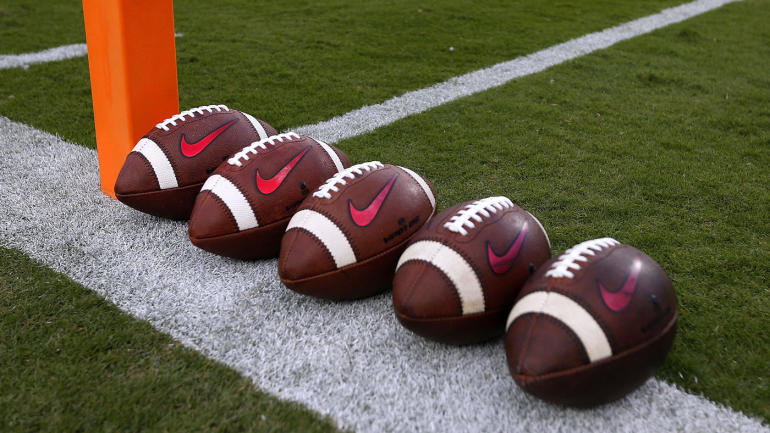
Only 6 percent of African-American men's basketball and football players could compete immediately upon transferring to another school under a proposal being considered by the NCAA Transfer Working Group, CBS Sports has learned.
The low number, a percentage of players who are estimated to have a necessary GPA of 3.3 or higher to waive the year-in-residence transfer restriction, has raised questions about racial inequality even though working group members have been told by the NCAA the changes are legally defensible, sources told CBS Sports.
The Big 12 faculty athletic representatives objected to the racially disparate impact of academic benchmarks in a letter sent in mid-April to the working group.
The letter reads, in part: "The NCAA [would have] adopted a transfer rule that it knew to a certainty would favor white student-athletes …"
The working group is at a point where it wants to "tap the brakes" on considering an academic benchmark, according to several sources. What is more likely to be approved as soon as this June is allowing athletes to notify coaches/schools of their intent to transfer instead of seeking permission.
This is in response to several high-profile stories that have emerged over the last few years with coaches "blocking" their players from transferring to certain schools for competitive or spiteful reasons.
Even getting to a point of rectifying that reinforces how difficult any transfer reform has been. In April, the NCAA Committee on Academics recommended a GPA-based academic benchmark. Critics immediately latched onto to the racial impact.
To some, the move smacked of Proposition 42 in the 1980s. Those initial eligibility rules were considered so discriminatory by some that then-Georgetown basketball coach John Thompson walked out of a game in protest.
"I hear it in the air. I hear it in conversations outside the meetings," said TCU faculty athletics representative Rhonda Hatcher, who also a member of the NCAA Committee on Academics that pushed the benchmark. "You want a relative high GPA because you don't want a lot of transfers in those sports [basketball and football]."
Hatcher was not individually in favor of the benchmark.
That is actually the antithesis of the mandate from the NCAA Board of Directors, which earlier this year called for fast-track reform.
CBS Sports was able to obtain data that was shared with the academic committee. The information isn't publicly available, according to an NCAA spokesman.
That committee put forth two academic grand point average benchmarks for research: 3.0 and 3.3. Whichever benchmark was eventually chosen, if met, would allow athletes to transfer and compete right away. The committee stated anything below a 3.0 puts athletes "at risk for taking longer to graduate -- or not graduate at all."
"In my view, [an academic benchmark] is a judgment call," Hatcher told the Knight Commission on Intercollegiate Athletics during hearings on Monday.
With a 3.0 GPA benchmark, 19 percent of African-American football and basketball players could transfer immediately. Factoring in all races, that figure is 30 percent overall in those sports.
With a 3.3 GPA benchmark, 6 percent of African-American football and basketball players could transfer immediately. Factoring in all races, that figure is 14 percent and 13 percent, respectively, in those sports. An overall figure was not available.
Research shows that 70 percent of white athletes in all NCAA sports achieve a 3.0 GPA, making them eligible for immediate competition if they transferred under this proposal. The compares to only 31 percent for African-American athletes in the same scenario, a gap of 39 percent. At a 3.3 GPA, 47 percent of transferring white athletes would be eligible to compete immediately, while 14 percent of African-American transfers would be similarly eligible, a gap of 36 percent.
"An academic benchmark would do much more to measure socio-economic background than it would academic effort or potential," the Big 12 faculty reps wrote, adding that it would "aggravate socio-economic differences rather than level the playing field."
Critics also argue an academic benchmark is detached from the data. Research shows that close to 80 percent of non-transfers with a 3.0 GPA eventually graduate. Transfers graduate at a 72 percent rate.
With it already known that non-transfers graduate at a higher rate than transfers, how does allowing any athletes to transfer improve graduation rates?
Complicating issues is the fact that 68 percent of all NCAA athletes are allowed to transfer and compete immediately. Only football, hockey, baseball and men's and women's basketball players must sit out a year.
Other non-revenue sports such as soccer, volleyball, tennis and golf, historically, do not produce revenue. They are, in fact, supported by the income produced by football and basketball that are the center of the transfer discussion.
The Big 12 faculty reps referred to those non-revenue sports when they wrote to NCAA officials that the current transfer policy "would favor white student-athletes whose efforts do not generate positive revenue over African-American student-athletes whose efforts do."
A source close to the process added: "I think what it will end up underlining is [that schools] are really keeping our foot on the neck of certain socio-economic backgrounds who are generating all money and are paying all the bills."
Though not directly related to this subject, the Congressional Black Caucus sent a letter to NCAA president Mark Emmert last week urging reform. In part, the CBC asked Emmert, "Is the NCAA's current operating model producing economic and racial inequality?"
In a wide-ranging proposal submitted earlier this year, the Big 12 advocated making transfers in all sports sit out a year. The league is believed to be the only Power Five conference to state its opposition to an academic benchmark.
The NCAA has told working group members that the legal liability of academic benchmark is lessened because the net effect would be more player freedom in transferring. It also continues to point out, as noted earlier, that players who do not transfer graduate at a higher rate. The Commission on College Basketball recently advocated that the year-in-residence stay in place for transfers in basketball.
Significant hurdles remain for further reform.
"If you have a 3.1 GPA and you're eligible, and I have a 2.9, I'm not eligible?" scoffed St. Joseph's basketball Phil Martelli, a member of the working group. "You know what I'd say next? 'See you in court.'"
One official envisioned a rash of waiver applications that would clog a transfer process that is meant to be simplified.
"We don't need to do something that is going to be debatable," said Iowa State athletic director Jamie Pollard. "If you put in an academic threshold, and I get concussed, [I can say], 'That's why I missed it by one percent.'"
The year-in-residence restriction traces its roots back 122 years, highlighting the difficulty the group will have making meaningful reform. Since the NCAA's April press release, there has been concern about the impact on minorities. African-Americans historically have overall lower graduation rates than whites.
One official close to the process portrayed possible legal liability this way: "Is [a benchmark] going to be defensible when some lawyer goes up and says, 'Let me understand this. You put in a rule that you knew statistically was going to injure African-American athletes.'"
The Big 12 faculty reps' letter went on to state: "An academic benchmark will favor white student-athletes over African-American student-athletes and student-athletes in non-revenue sports over those in revenue sports. The resulting criticism in the media (and perhaps the courtroom) is both highly foreseeable and potentially devastating."





















